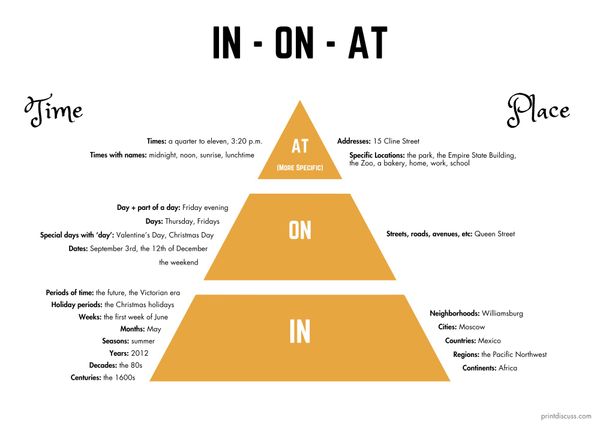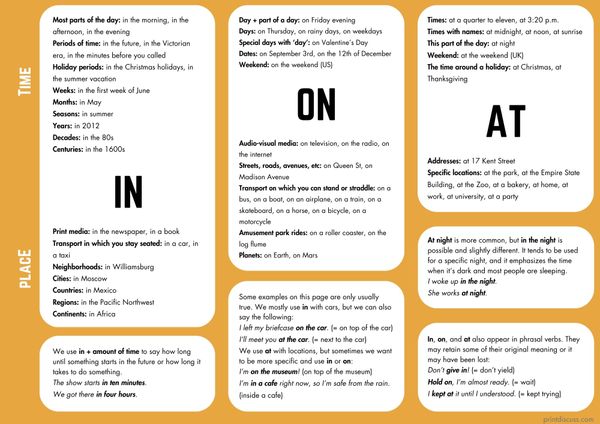Learning When to Use In, On, and At
It’s understandable that students get confused when using prepositions like in, on, and at, even as they reach a high level of fluency. Errors with these words don’t always matter for communication, but we aim to be as accurate as possible.
Knowing the basic location meanings of these two-letter words is important and easy enough. For children and beginners we can demonstrate them with simple diagrams. Only the meaning of at is a bit less concrete. It’s not distinguishable from next to or near in these kinds of images.
In expresses being enclosed or surrounded.
On means something is resting on a surface.

However, there are many other uses for these prepositions, and it can be hard to see a connection to those original locative meanings.
When using in, on, and at for time and location, it might be helpful to notice a trend from broader concepts toward smaller, more specific ones. Take a look at my version of the In-On-At pyramid:

For printing, the PDF version is ideal.
In the pyramid, I’ve only included the uses that fit the pattern of getting more specific toward the top, and that means a few things were left out. In the chart below, I’ve tried to include the missing elements as well as a few other things to be aware of with in, on, and at usage.

Here is a printable PDF version.
The chart is quite word-dense, so I don't envisage it being used on a wall. However, it might be useful as a reference. Down below, I spell out exactly what has been added to this second chart.
Parts of the day: generally, in the morning, in the afternoon, in the evening, and at night. However, we sometimes say in the night, and I’ve included a note about this.
Periods of time: this was included on the pyramid, but the examples were only large periods to fit with the trend. However, periods of time can be small too. They just tend not to have names.
Media: we use in with print media and on with audio-visual media.
Weekends: I’ve included on the weekend, the American standard, and at the weekend, the way it’s generally said in the UK.
Transport: I’ve divided this into that which pretty much restricts you to your seat and combines with in (cars, taxis, vans) and that which you can stand in or straddle a seat and combines with on (airplane, train, boat, bicycle). It’s possible to use in with those words to emphasize how you’re inside or to specifically say you’re in the cabin of a boat, for example.
I’ve added amusement park rides and planets (both on).
I’ve referred to how we use in + an amount of time to say either when something starts in the future (The train leaves in two hours), or how long something takes (We did it in a week).
In the chart, there is also a blurb about phrasal verbs (which frequently feature in, at, or on) and another part about how sometimes we choose a different preposition for specificity.